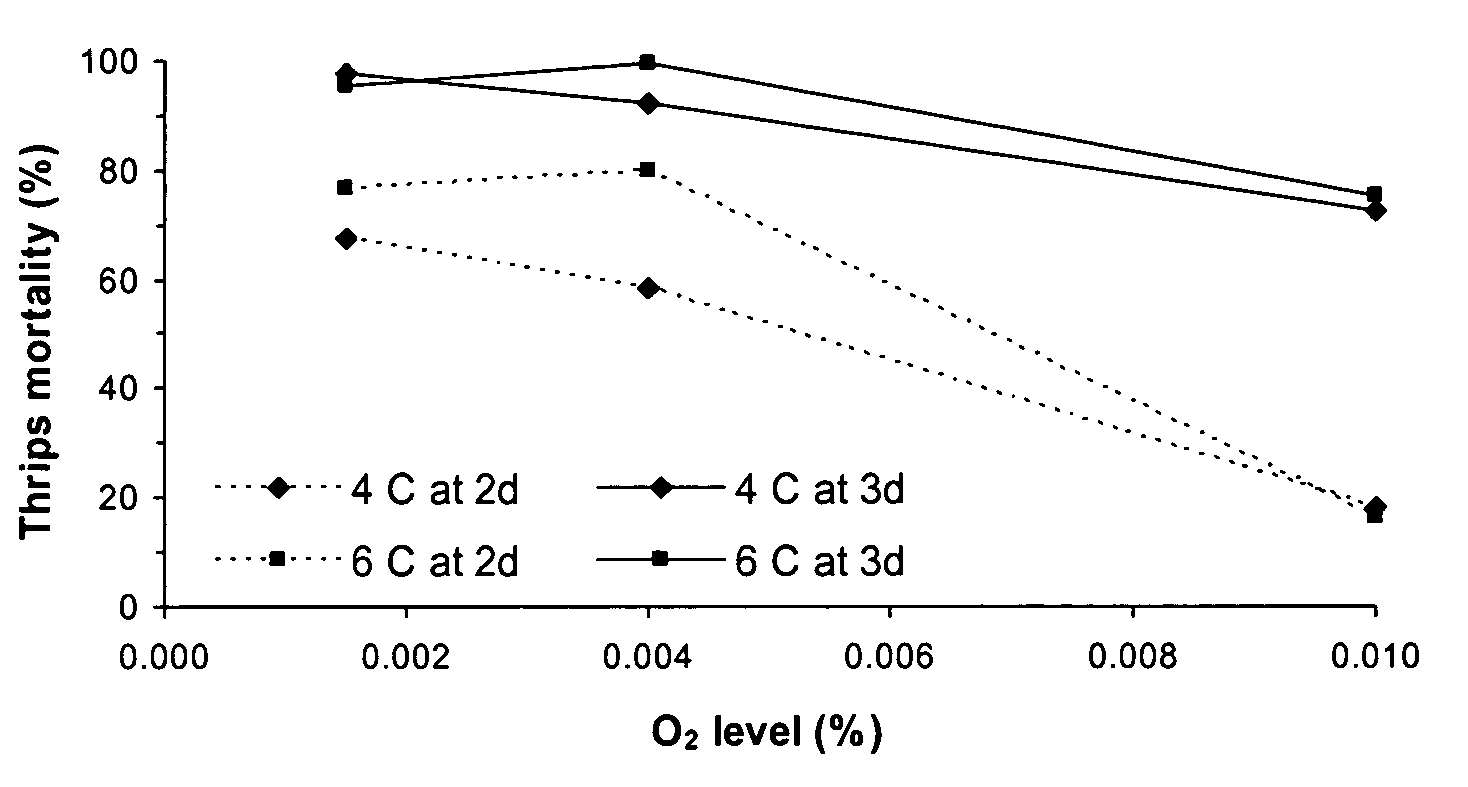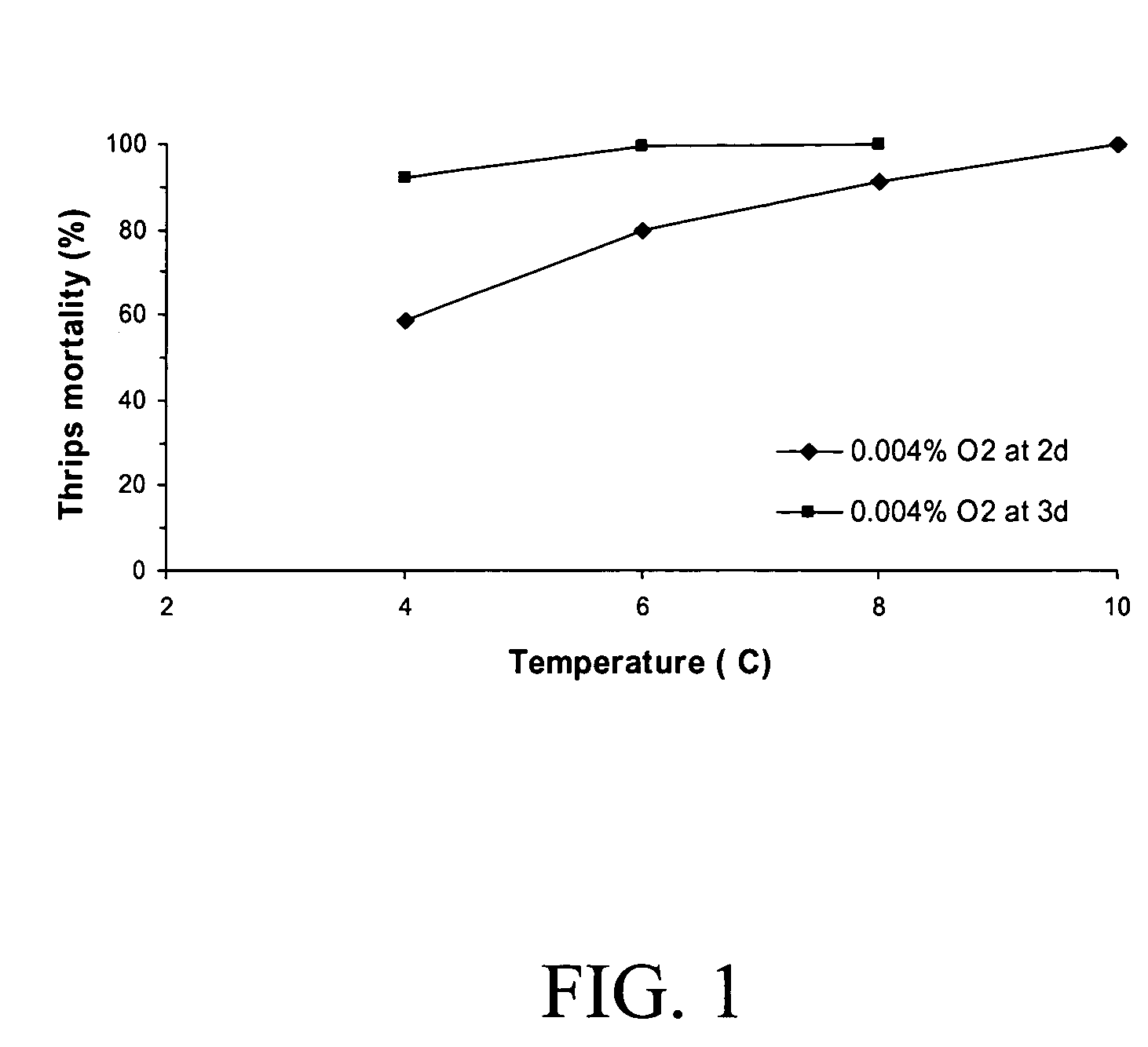Ultra-low oxygen treatment for post harvest pest control on agriculture products
a technology of pest control and ultra-low oxygen, applied in the field of ultra-low oxygen treatment for post-harvest pest control on agriculture products, can solve the problems of brain damage, methyl bromide is extremely toxic, and consumers are prone to toxicity
- Summary
- Abstract
- Description
- Claims
- Application Information
AI Technical Summary
Problems solved by technology
Method used
Image
Examples
example 1
Ultra-Low Oxygen (ULO) Treatment for Control of Western Flower Thrips on Broccoli
[0058]Western flower thrips are a common pest on a wide variety plants and is quarantined or restricted on some overseas markets e.g., Taiwan and Japan. The pest problem affects export of U.S. broccoli because the cost for the required fumigation treatment at the port of entry is often prohibitive.
[0059]Typically, broccoli is shipped on ice at low temperature. Unfortunately, chemical fumigation is conducted at ambient temperature and therefore is not compatible with typical shipping methods of broccoli. Furthermore, the common fumigant methyl bromide causes ozone depletion and its production is to be phased out. As the following Example illustrates, Western flower thrips were successfully controlled using ultra-low oxygen treatment at different temperatures.
[0060]In one experiment, thrips were completely controlled at low temperature (1° C.), with ULO treatment at 0.003% oxygen in 5 days (Table 1). In a...
example 2
Materials and Methods for Example 2
[0068]Insects. N. ribisnigri colonies were established from field collected insects in 2001 and were reared on lettuce plants in screen cages in a greenhouse. N. ribisnigri newly collected in 2003 were added to the colonies. For each test, apterous N. ribisnigri were placed on lettuce leaf pieces in plastic Petri dishes (5.5 cm diam, ≈15 aphids per Petri dish) and the Petri dish tops were secured to the bottoms with tape. The Petri dishes had narrow spaces between the tops and the bottoms that permit ventilation. Alates were collected in plastic vials (2.5 cm diam.×7 cm high, 10-15 alate / vial) containing a piece of lettuce leaf using a vacuum powered aspirator. The vials were sealed with lids with screened windows for ventilation.
[0069]Effects of small-scale ultra-low oxygen treatments on insect survival. Ultra-low oxygen conditions were established in large drum chambers filled with lettuce by intermittently releasing N2 and air into the chambers....
example 3
Ultralow Oxygen Treatment for Vine Mealybug Control on Grape Rootstocks
[0075]Butternut squashes infested with vine mealybugs were confined in cardboard box and placed in treatment chambers made of plastic containers together with dormant grape rootstocks. Different combinations of oxygen level, temperature, and treatment time were tested. After each test, the squash was kept in an environmental chamber for one day before scoring mortality of vine mealybug. Mortality of all life stages: egg, crawler, nymph, and adult were determined. Eggs were collected from the treated squash and placed in vials. They were checked periodically over time to check the presence of crawlers from hatched eggs. Crawlers, nymphs, and adults were removed from the surface of the squash and checked for mortality under a microscope. ULO treatment with 10 ppm (0.001%) oxygen at 20° C. for 3 days was effective in controlling all life stages of vine mealybug. This treatment was replicated 3 times. Rootstocks from...
PUM
 Login to View More
Login to View More Abstract
Description
Claims
Application Information
 Login to View More
Login to View More - R&D
- Intellectual Property
- Life Sciences
- Materials
- Tech Scout
- Unparalleled Data Quality
- Higher Quality Content
- 60% Fewer Hallucinations
Browse by: Latest US Patents, China's latest patents, Technical Efficacy Thesaurus, Application Domain, Technology Topic, Popular Technical Reports.
© 2025 PatSnap. All rights reserved.Legal|Privacy policy|Modern Slavery Act Transparency Statement|Sitemap|About US| Contact US: help@patsnap.com



